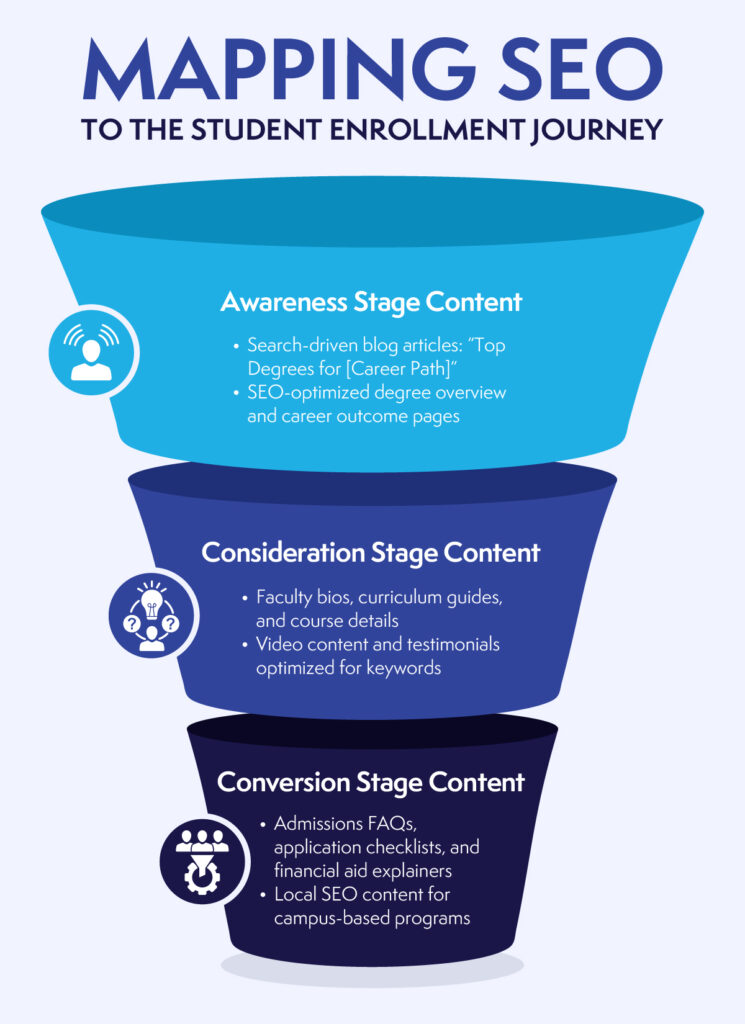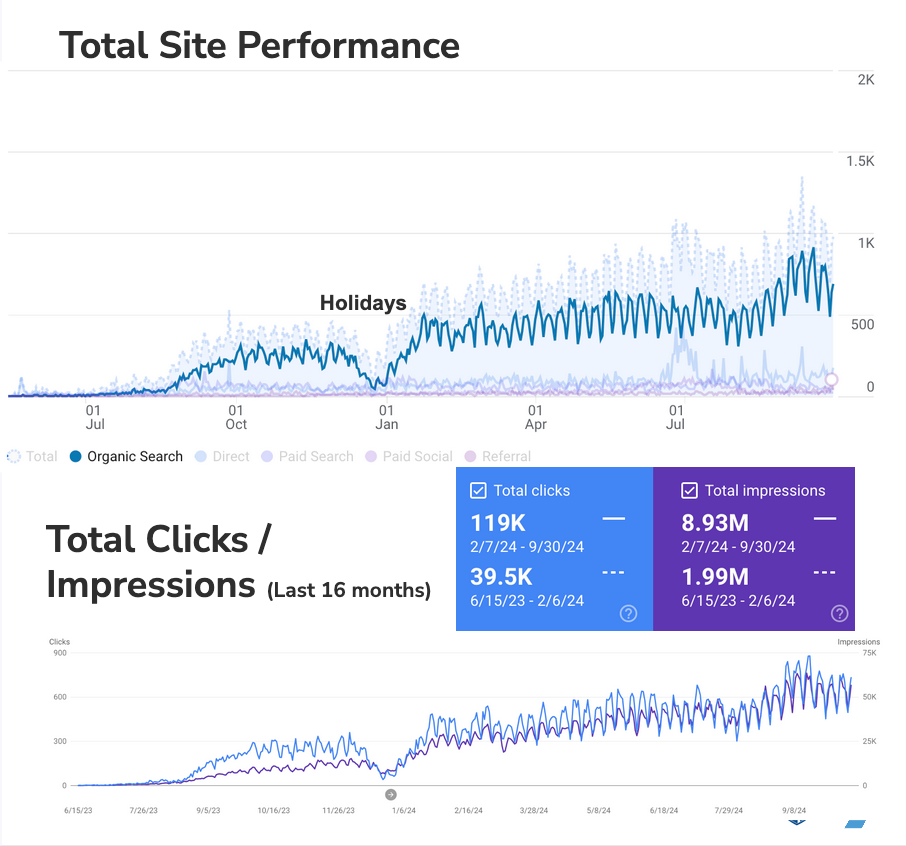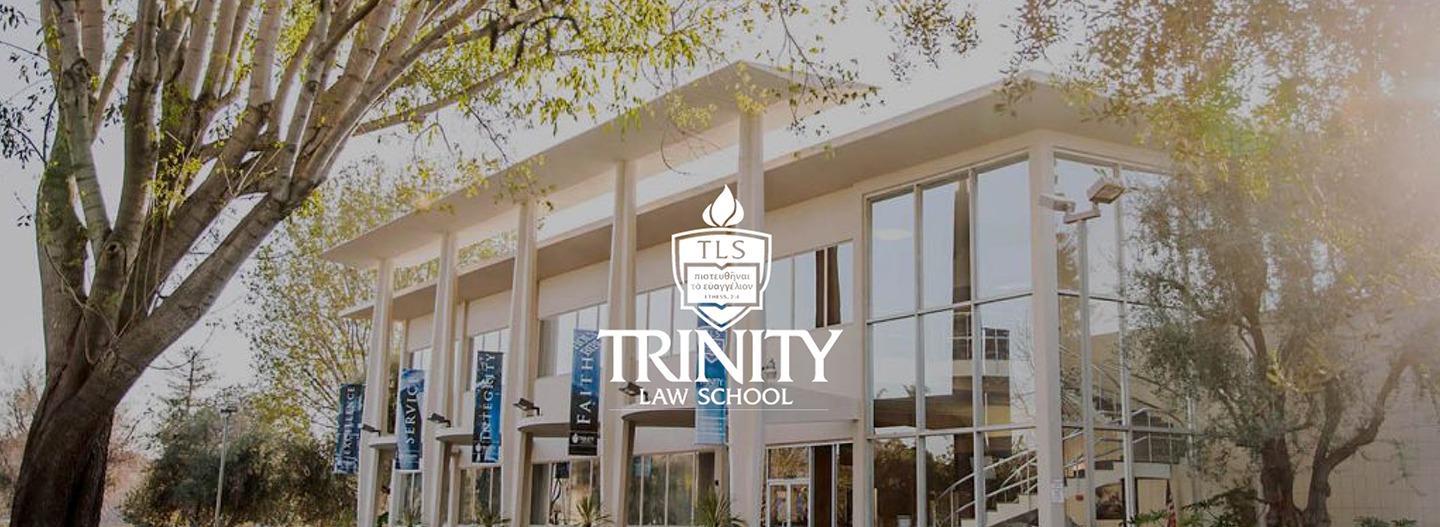How SEO for Universities Powers Sustainable Enrollment Growth
There’s a good chance you landed on this article after typing a question or a set of keywords into a search engine. That’s because we optimized this article for said search using search engine optimization (SEO) strategies. As a university marketer, you should be doing the same thing to reach prospective students.
Today’s recruitment landscape is digital, and a search engine query is often the first and most critical step a prospective student takes toward enrolling. SEO for universities is a central driver of discoverability, engagement, and application starts.
By employing higher education SEO tactics and investing in strategic, search-focused marketing, institutions can build sustainable enrollment pipelines. But how do you build an SEO strategy that goes beyond plugging keywords into program pages?
In this article, we’ll cover:
- Why search is the cornerstone of student decision-making.
- How SEO aligns with every stage of the enrollment funnel.
- How universities can improve their rankings, engagement, and lead quality.
- Why higher education SEO efforts deserve long-term strategic investment.
Why Universities Use SEO Strategies for Enrollment Growth
In an increasingly competitive enrollment landscape, SEO offers higher education institutions a sustainable, cost-effective foundation for long-term growth. Unlike time-limited paid campaigns, SEO builds momentum and equity over time, positioning your institution in front of prospective students at the exact moment they’re looking for options.
Today’s Students Start With Search
Before a prospective student ever talks to an admissions counselor or clicks on an ad, they almost always begin with a Google search. In fact, a majority of students report using search engines as their first step in looking for college and university options, according to recent research from EAB and Modern Campus.
If your institution doesn’t show up organically on the first page of results, you’re not in the conversation.
What makes organic search results particularly powerful is the trust factor. While ads can drive visibility, organic rankings signal authority, relevance, and credibility, especially in the eyes of Gen Z prospects, who are increasingly ad-skeptical and research-savvy.
Additionally, mobile-first behavior and voice-assisted searches for terms such as “best online MBA program in Texas” or “affordable RN to BSN degree near me” raise the stakes for technical SEO. A university’s site must not only be optimized for keywords but also be fast, intuitive, and responsive to be able to meet students where they are: on their phones, on the go, and expecting answers immediately.
Long-Term ROI of Organic vs. Paid Media
SEO is an investment, not a line item. While a paid search ad can generate quick visibility, it’s fleeting, as your ad disappears the moment the budget runs dry. But SEO creates a compounding return. Each blog post, landing page, and FAQ that’s optimized for student search behavior becomes an evergreen asset that continues working long after it’s published.
Over time, this strategy leads to a lower cost per inquiry compared to paid media. And, more importantly, SEO brings in better-qualified leads from students who find your programs through specific, intent-driven queries. They are more likely to be engaged, aligned with your offerings, and prepared to convert.
Mapping SEO to the Student Enrollment Journey
To maximize the impact of SEO for your university, you need to guide prospective students through a decision-making journey that’s often long, nonlinear, and filled with questions. The most effective SEO strategies map content to each stage of the enrollment funnel, from first touch to final application.
Awareness Stage Content
At the top of the funnel, students are exploring their options. They’re not searching for your university by name. They’re asking broad, future-focused questions such as “What degree do I need to become a UX designer?” or “What are the best jobs in environmental science?” This is where search-driven blog content plays a critical role.
By creating optimized articles with titles such as “Top Degrees for a Career in UX Design” or “10 Top Environmental Science Jobs in the Next Decade,” an institution can capture early interest from prospective students who haven’t yet narrowed their choices. These types of pieces not only build organic traffic to your site but also establish your institution as a thought leader in career-aligned education.
SEO-optimized pages that provide detailed degree overviews and career outcome lists can further reinforce your institution’s relevance while helping students begin to connect their goals to your academic offerings. Remember: This stage is about visibility and value, not a hard sell.

Consideration Stage Content
Once students have a clearer sense of their path, they shift into the consideration phase, digging deeper into specific programs and comparing schools. They want evidence of factors such as faculty expertise, curriculum relevance, and positive student experiences.
This is where midfunnel content shines.
Detailed faculty bios, curriculum guides, and sample course descriptions — each optimized for key search phrases — can improve your search rankings while offering meaningful substance to prospective students. For example, a student researching “online master’s in public health with epidemiology focus” should land on a program page that mirrors those terms and provides them with real answers.
Video content, especially when paired with keyword-rich titles and descriptions, helps tell the story of your institution in a more human, engaging way. Students’ testimonials, day-in-the-life videos, and faculty spotlights can also help move students from interest to intent, especially if that content is discoverable via search.
Conversion Stage Content
As prospective students near a decision, they seek clarity and confidence. They’re looking for reassurance that they can take the next step, and that it’s the right one. Conversion-stage SEO content should answer students’ practical, high-intent queries about your institution, such as “how to apply to [University Name],” “[University Name] financial aid for graduate students,” or “[University Name] application deadlines for fall 2026.”
For institutions with campus-based programs, locally oriented SEO becomes critical at this stage. Optimizing for geographic search terms, such as “colleges in Chicago with data science programs,” ensures you show up in local map packs (the local business listings that appear with a map in location-based Google searches), directory listings, and mobile searches.
It’s about being visible and accessible right when students are ready to act.
Optimized admissions FAQs, application checklists, and explainers on cost, scholarships, and financial aid reduce friction and address students’ common concerns. These pages nudge students across the finish line.
Proven SEO Strategies for Universities
To truly move the needle on enrollments resulting from organic search results, universities need to go beyond the basics of content creation. SEO success in higher education relies on a layered approach that blends technical excellence, strategic content development, and an optimized student experience.
Technical SEO as a Foundation
No matter how compelling your content is, it won’t perform if search engines can’t access and interpret it. That’s why technical SEO is the critical first step in building your search visibility.
To help your site show up in search results, you need to fix problems such as broken links, too many redirects, slow-loading code, or pages that are hard for search engines to reach. Tools like Google Search Console and Screaming Frog can help you identify these hidden roadblocks.
One particularly valuable tactic for universities is adding schema markup — structured data tags — to your content, especially on pages with information designed to respond to high-intent queries, such as those containing academic program descriptions, faculty bios, and FAQs. With schema, search engines can better understand the structure and purpose of your content, making it eligible for rich results, such as showing up in featured snippets and accordions. That visibility boost often translates into higher click-through rates from searches.
Content That Matches Searchers’ Intent
Great university SEO content is as student-centric as it is keyword rich. The most effective universities use keyword research to inform their content strategy, ensuring that it aligns with the questions, concerns, and goals of prospective students.
This includes building program clusters, or content hubs, around key degree areas. For example, a hub for your Master of Science in Data Science program might include pages on career paths, curriculum breakdowns, faculty Q&As, students’ success stories, and downloadable guides — all linked together to establish topical authority.
Modern search results also reward content that demonstrates experience, expertise, authoritativeness, and trustworthiness (EEAT). Universities are naturally well positioned to feature real instructors, cite data, and include named authors with academic credentials to increase their credibility with both students and algorithms.
Student Experience + SEO
The student experience is not separate from SEO. Google’s algorithm increasingly favors sites that provide clear, intuitive pathways to information, particularly on mobile devices.
For universities, that means streamlined site navigation and a logical content hierarchy that surfaces pages with key data such as program offerings, admissions steps, and tuition details within two or three clicks from the homepage. Critical content shouldn’t be buried beneath layers of institutional jargon or outdated menus.
Internal linking is another underrated but powerful tactic. By connecting related content — such as linking from a faculty bio to a program page, or from a blog post to an application checklist — you improve the crawlability of your site, increase the depth of information you provide on a topic, and keep students engaged longer.
The result? Higher page authority, better rankings, and more informed prospective students.

Treating SEO as a Strategic Enrollment Asset
In many universities, SEO is still siloed within the marketing team and treated as a narrow tactic for improving search engine rankings. But SEO should be reframed as a long-term, strategic asset that drives enrollment growth and informs data-driven decision-making.
Holistic Attribution Models
One of the biggest missed opportunities in SEO for universities is how it’s measured. Traditional models often rely on last-click attribution, a model that gives 100% of the credit for a conversion to the final touchpoint a student interacted with before taking action. This underrepresents SEO’s influence, particularly in a student journey that spans weeks or months and touches multiple channels.
Universities should adopt holistic attribution models that track assisted conversions, or interactions a student has with your marketing channels that contribute to their conversion, not just their final clicks. A search may not be the student’s last touchpoint, but it often plays a vital role in their early awareness or during their midfunnel research. Ignoring that role means underinvesting in a channel that silently drives consideration.
To see the full picture, it’s essential to align tools like Google Search Console and Google Analytics with your customer relationship management (CRM) system. Mapping behaviors based on organic search results, like blog visits, program page views, or FAQ engagement, to downstream enrollment actions helps quantify SEO’s true impact and justify investment at the leadership level.
Collaboration Across Teams
Your SEO team shouldn’t live in a vacuum. They intersect with admissions, content strategy, web development, student experience, and even academic department teams. When these teams operate separately, SEO efforts stall. But when collaboration is intentional, the entire enrollment ecosystem benefits.
For example, admissions teams can surface real students’ questions to inform keyword targeting. Student experience teams can help optimize navigation for both search bots and prospective students. Academic departments can contribute subject-matter expertise to improve your pages’ EEAT and topical depth.
SEO-informed content planning — whether for a blog calendar, landing page update, or digital ad campaign — ensures every piece of your content is geared toward a discoverability goal. This strengthens your SEO’s performance and boosts the efficiency of your other marketing channels, from paid search ads to email nurture campaigns.
Preparing for What’s Next
The SEO landscape is evolving rapidly, and universities need to anticipate what’s coming, including search tactics driven by artificial intelligence (AI). With Google’s AI Overviews (also known as Search Generative Experience, or SGE), zero-click searches, and the growing prominence of featured snippets, institutions must rethink how visibility is defined.
Ranking No. 1 doesn’t guarantee clicks if the answer is shown directly in the search result. That’s why future-ready SEO strategies focus on content depth and authority. Winning in AI-driven search engine results pages requires comprehensive, well-structured content that answers layered queries, not just surface-level questions.
Institutions should also monitor how AI tools interpret their content and brand. Structured data, semantic markup, and content clarity all influence how your pages are represented in machine-generated summaries and voice search results.
Bonus: See our full article on AI-driven search, “Generative Engine Optimization (GEO) for Higher Education.”
Ready to Make SEO a Strategic Pillar for Your School?
SEO for universities isn’t a mere marketing tactic. It’s a foundational strategy for long-term enrollment growth, helping to future-proof your institution’s enrollment efforts in a volatile higher education market.
While SEO is critical, it’s also complicated, which is why Archer Education provides colleges and universities with the expert insights required to create a truly strategic SEO plan that integrates with other elements of your marketing strategy.
Contact us to learn more about how SEO can ignite your institution’s growth over the long haul.
Sources
EAB, “The Top 5 Ways Prospective Graduate and Adult Learners Are Finding Your Programs”
